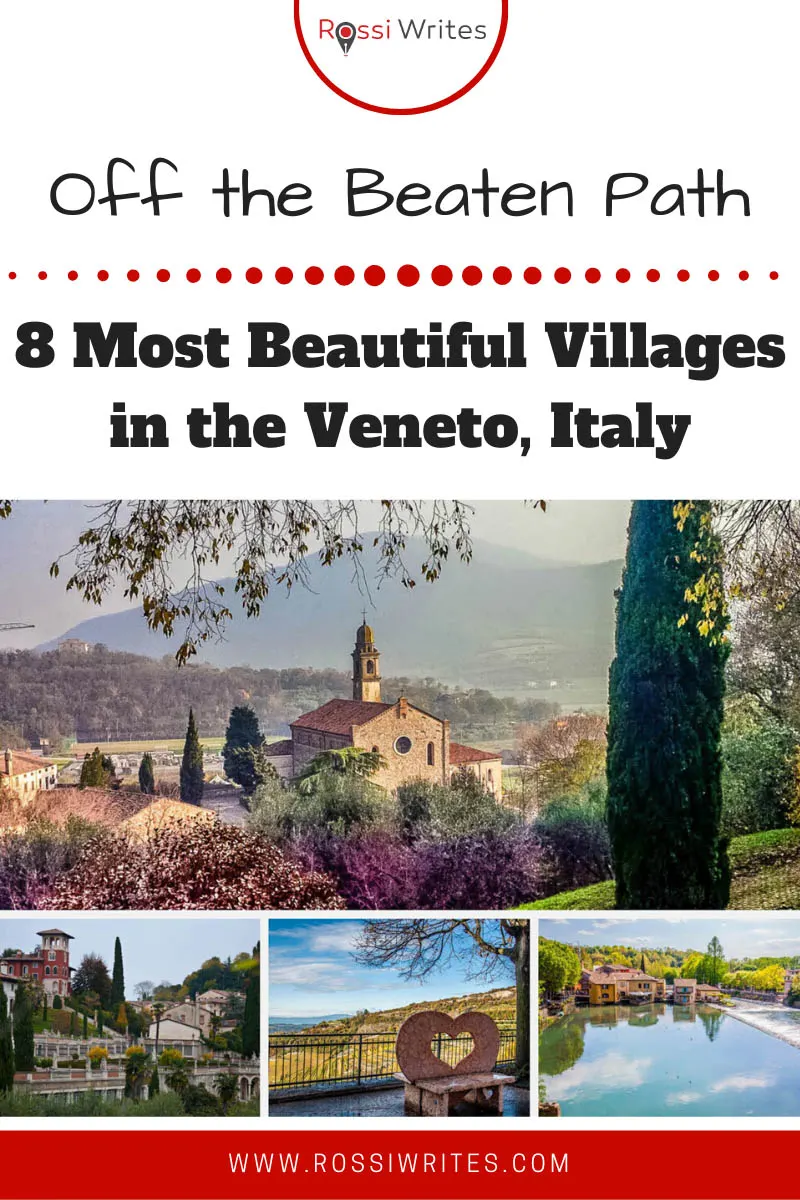Veneto is the Northern Italian region that millions of people flock to every year for they are eager to ride a gondola in Venice or see Juliet’s balcony in Verona.
Yet, these two tourist magnets are not all that’s special about the Veneto and if you are eager to get off the beaten track and delve into authentic local traditions and stunningly beautiful views, you need to come here pronto.
For, among the plethora of larger and smaller cities and towns that the Veneto calls its own, there is also a gaggle of picture-perfect villages where you will fall in love with the beauty of life again and again and where you can rediscover the true meaning of peace and quiet.
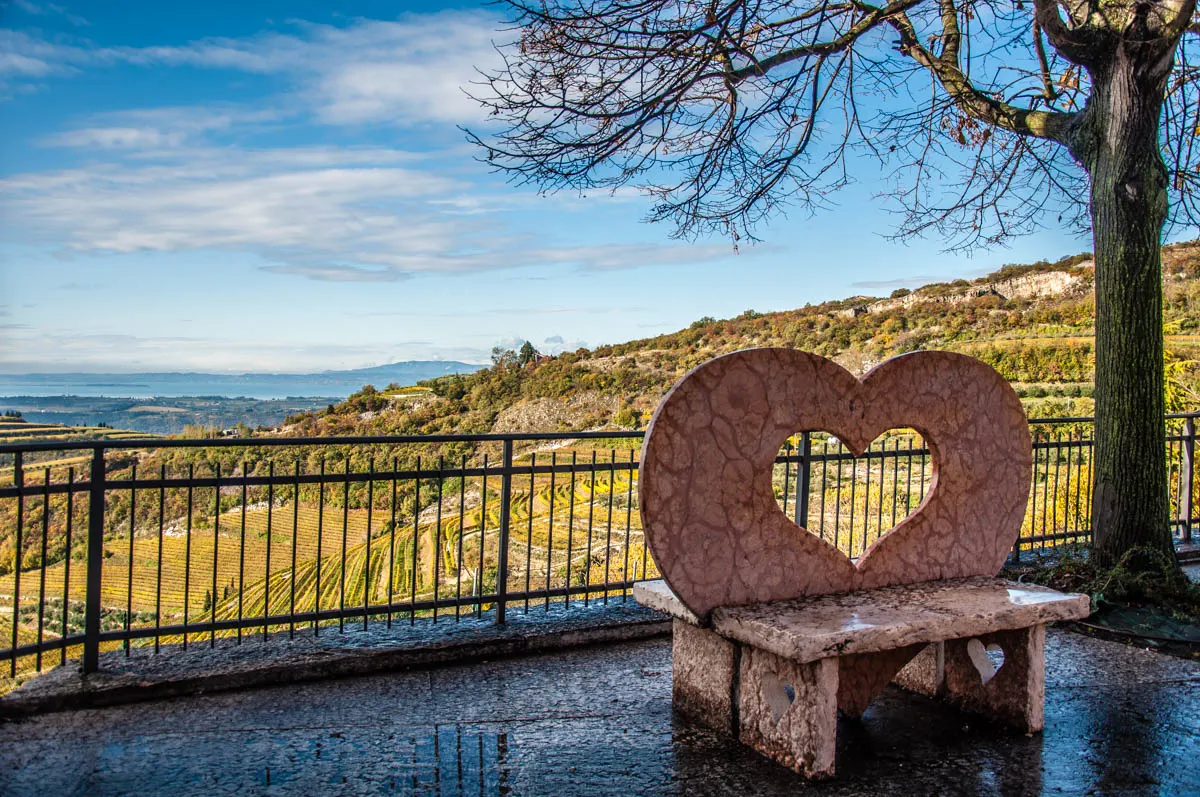
Today, I want to introduce you to eight of the most beautiful villages in the Veneto, Northern Italy. Huddled on top of picturesque hills, built right next to fast-running rivers, commanding breathtaking views over mountains and plains, infused with legends and history, Veneto’s villages are a joy to discover.
And while they may have not been originally on your Italy’s bucket list, a short trip to one or more of them will prove it to you that good things, indeed, come in small packages.
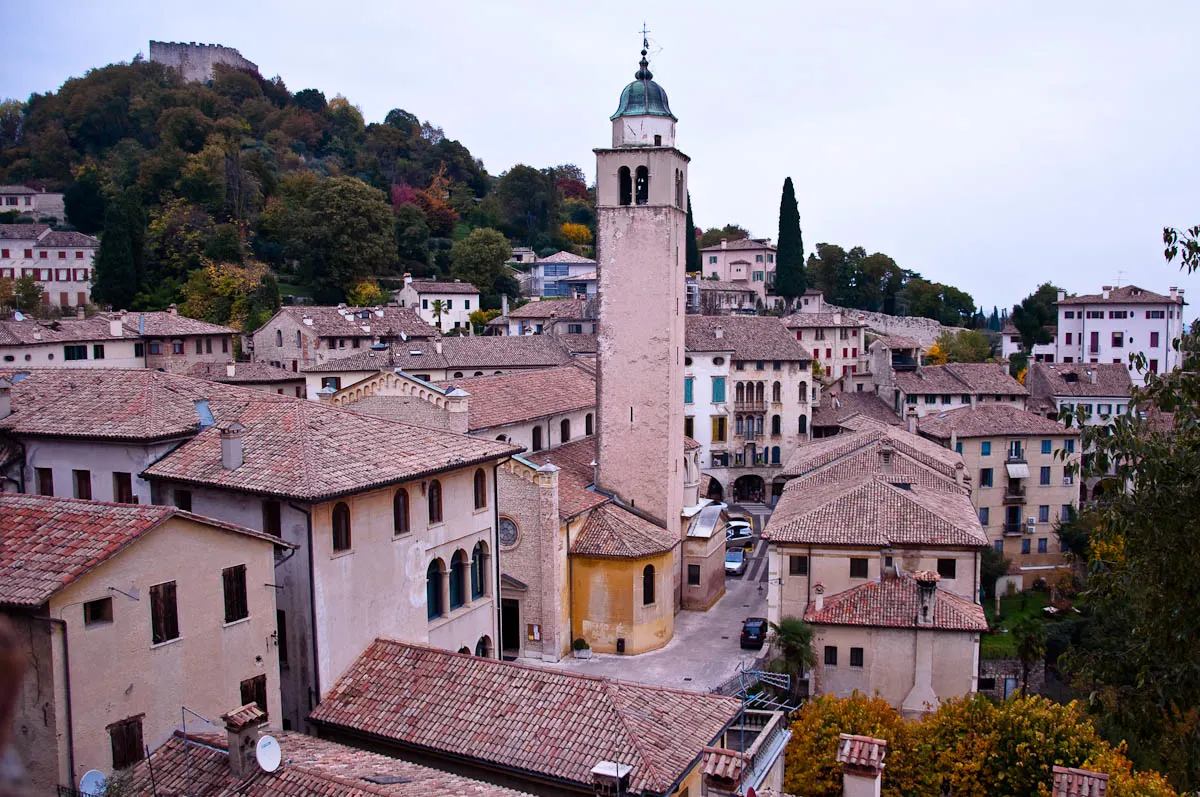
So, without further ado, let me introduce you to the:
8 Most Beautiful Villages to Visit in the Veneto, Italy
Arqua’ Petrarca, Province of Padua
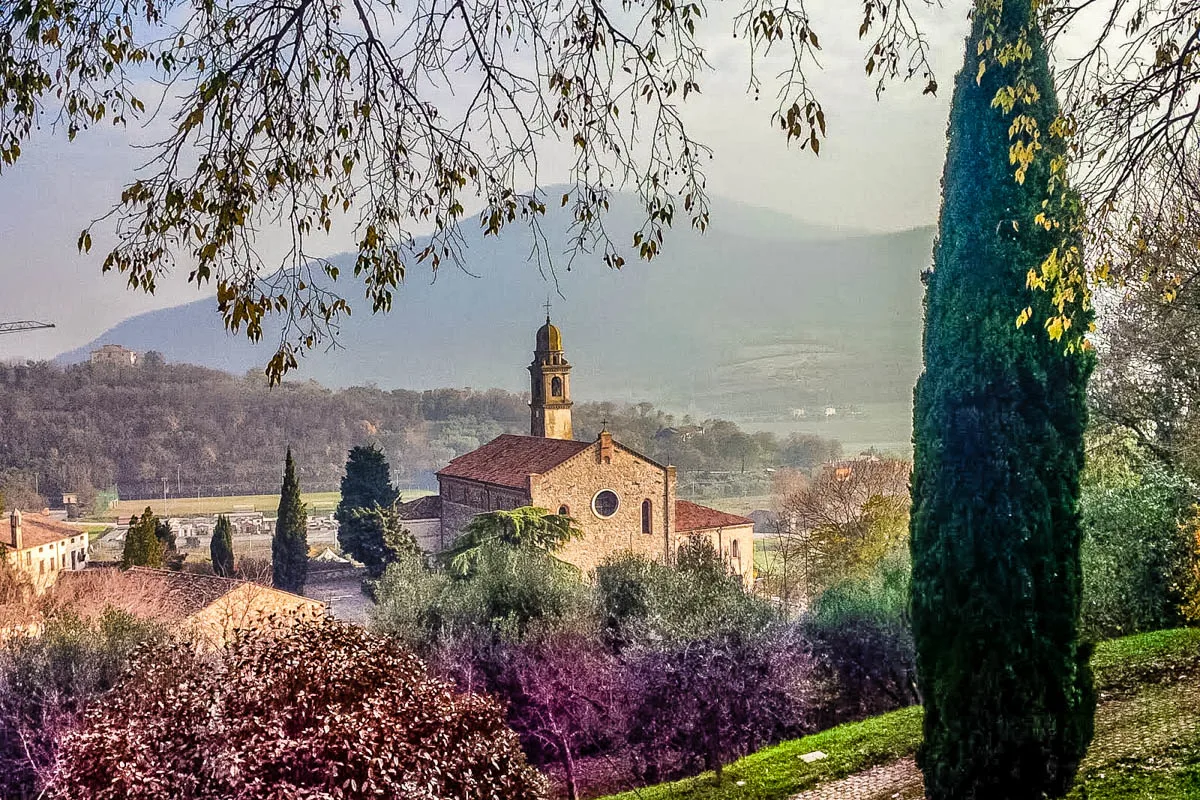
Perched on top of a steep hill, Arqua’ Petrarca is a medieval village of stone houses and cobbled streets. Surrounded by the stunning panorama of the Euganean Hills – a volcanic group near Padua – it’s like time has stood still here for centuries.
Olive and almond groves, vineyards, and lavender fields surround Arqua’ Petrarca. It’s a picturesque spot that seems plucked from the stage of an Italian opera.
Such is the village’s beauty that even the Father of Humanism Petrarch – a renowned poet and scholar who helped spark the Italian Renaissance – fell in love with it. In 1369, he oversaw the renovation of a house there that had been bought for him by a benefactor. In the following year, Petrarch moved to Arqua’ – as the village was known then – to spend the last years of his life there.
Petrarch’s house is still there and is open for visits. Its rooms are fully frescoed. The verandah overlooks the Euganean Hills. On the outside, the house is surrounded by a lush garden, where Petrarch, allegedly, liked to potter around.
So honoured were the residents of Arqua’ by Petrarch’s presence, that they added his Italian surname – Petrarca – to the name of their village.
The poet is also buried in Arqua’ Petrarca and his monumental tomb of red Verona marble stands outside the parish church of Santa Maria Assunta.
In addition to exploring Petrarch’s legacy, you can also use your time in Arqua’ Petrarca to:
- see the Oratory of the Holy Trinity and the Vicars’ Lodge;
- go for a walk to the nearby small lake Costa where archaeological finds from the Copper and the Bronze Ages have been discovered; and
- sample the local olive oils, wines, as well as lavender- and almond-based products.
What else to see nearby:
You can combine a visit to Arqua’ Petrarca with a further exploration of the lush Euganean Hills. From medieval walled towns to hiking paths and thermal baths, there are many things to see and do there. Este and Monselice are two walled towns around 15 mins away each. There you can see castles, defensive walls, and churches among many other things. Plus, Este has a superb archaeological museum. The monumental Valsanzibio Gardens are less than 10 mins away. There you can admire Italian gardening art’s best traditions. Abano Terme and Montegrotto Terme are two towns in the Euganean Hills that are famous for their hot thermal waters. Both are less than 30 mins away. Or you can drive for around 25 mins to visit the Praglia Abbey – a Benedictine community that can be visited as part of a guided tour.
Click here for more information:
- The Sunset that Petrarch Enjoyed
- Este, Italy – Top 9 Things to Do in This 3,000-Year-Old Walled Town
- 3 Ideas for a Great Day Out in the Euganean Hills
Asolo, Province of Treviso
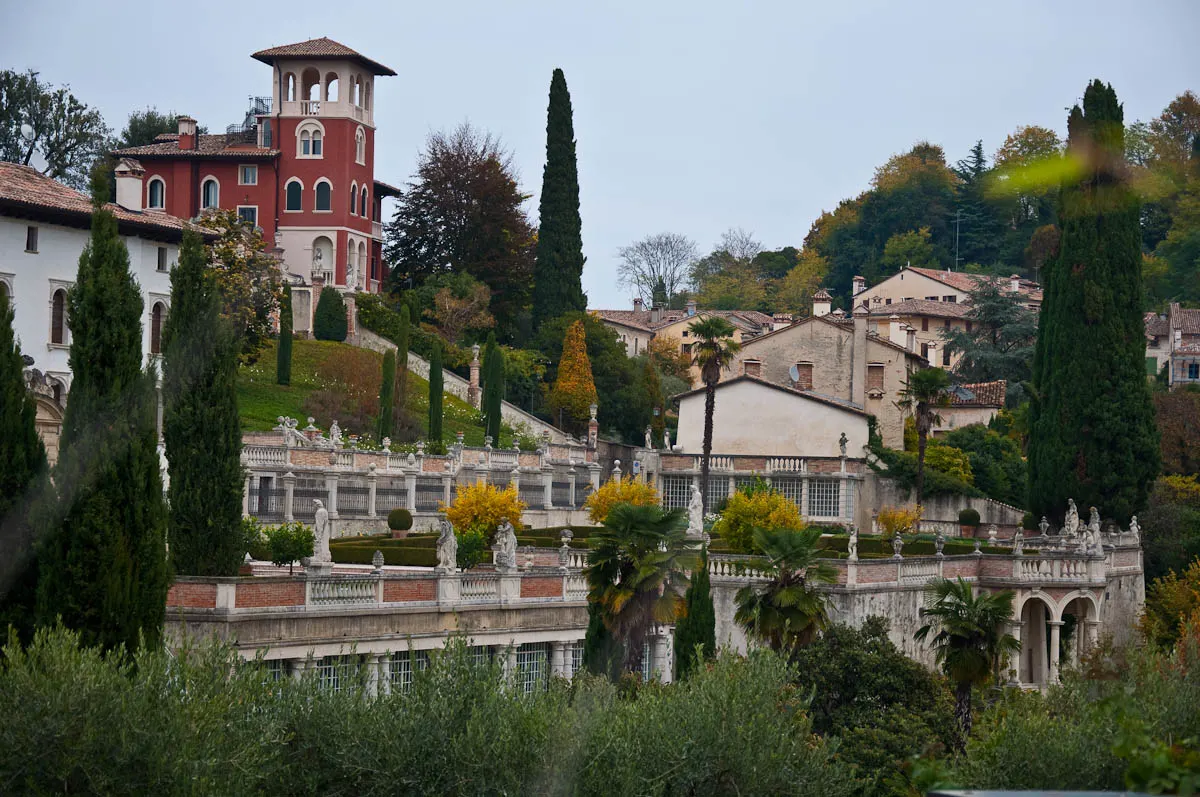
Hilltop Asolo is a heart-warming and soul-inspiring place that has been attracting royals, poets, and artists for centuries. With its stone houses, elegant villas, and lush gardens, simply going for a walk around Asolo becomes a pure act of beauty.
You will find Asolo in the Province of Treviso in the Veneto. Nowadays, the village is a peaceful place with stunning views over the Asolani Hills, the Eastern Alpes, and the Venetian plains. So it comes as a bit of a surprise to find out that centuries ago, Asolo was the seat of a royal court. A stone castle in Asolo’s historic heart is a testament to it.
This is where Catherine Cornaro – Queen of Cyprus, Jerusalem, and Armenia – ruled at the end of the 15th century. After the death of her husband King James II, Catherine had to cede the administration of Cyprus to the Republic of Venice. In exchange, the Republic allowed her to retain her regal title and gave her to Asolo to reign over.
Since then many renowned people and celebrities of the literary and artistic world have made the pilgrimage to Asolo to enjoy its beauty. Among them stand out the English poet Robert Browning, the Italian actress Eleonora Duse, the American author Ernest Hemingway and the Anglo-Italian travel writer and explorer Freya Stark.
Follow in their steps and discover all of Asolo’s gems for yourself. Among them are the Cornaro Castle, the stone fortress on top of Mount Ricco, the town museum, the cathedral, the many palazzi and villas dotted around town, and the Lombard House with its weird and whimsical stone decorations.
What else to see nearby:
You can combine a visit to Asolo with one of many other exciting destinations in this corner of the Veneto. Less than 15 mins away by car you will find the stunning Villa Barbaro (also known as Villa di Maser) – a Palladian masterpiece fully frescoed by Veronese. Also, less than 15 mins away by car is the Barco of Queen Catherine Cornaro – a building used by the Queen during her sojourns to the countryside. If you are a fan of Carlo Scarpa’s architectural designs, then don’t miss a visit to the Brion Cemetery which is only around 10 mins away from Asolo. Just under half an hour away you will find Possagno – a small village where Italy’s most renowned Neoclassical sculptor – Antonio Canova – was born and is buried. A little bit further away from Asolo, stand the beautiful towns of Castelfranco Veneto and Cittadella. Both are atmospheric walled towns where you will feel transported back to Italy’s Middle Ages. A visit to the beautiful city of Treviso from Asolo is an easy feat with travelling time of around 50 mins between the two.
Click here for more information:
- Asolo – The Soul Asylum of Artists and Royals
- Photos of Villa Barbaro (also known as Villa di Maser)
- Discovering Canova – Italy’s Neoclassical Sculptor
- The Medieval Fair in Castelfranco Veneto, Italy
- Photos of Treviso
Borghetto sul Mincio, Province of Verona
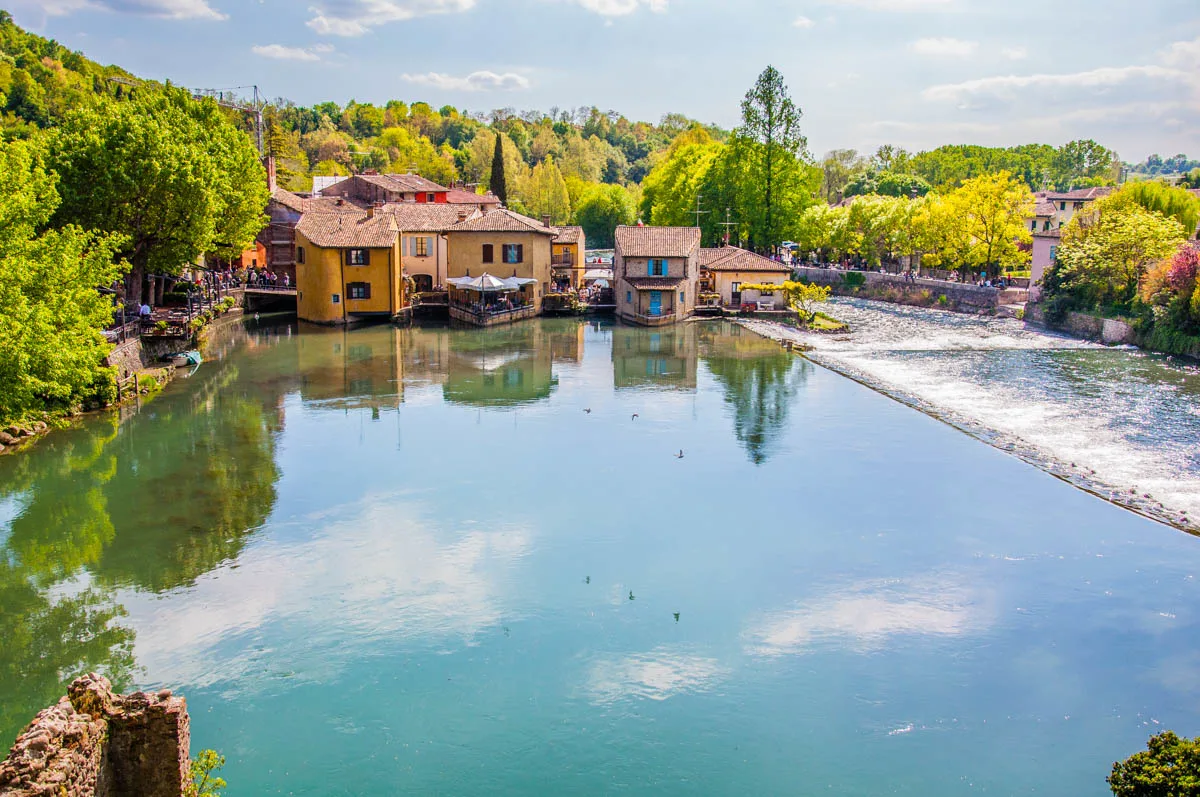
Borghetto is a little hamlet of old mills that grabs the heart and the imagination with its picturesque location over the fast-running waters of the river Mincio. The mills are nowadays converted into restaurants serving the local specialty – tortellini – which are also known as love-knots and have different seasonal fillings.
In spring, lush wisteria vines drape themselves over Borghetto’s fences and porches filling the air with the sweet smell of their purple blooms. Large peach orchards on the outskirts of Borghetto are a delight to see, too when – again in spring – their gnarly branches dress up fully in pink.
The hamlet is very nice to go for a walk around. A couple of shops sell lovely local arts and crafts. Gorgeous swans and cheeky ducks swim in the river. A large castle built by the Scalla family – the medieval Lords of Verona – stands proud and tall on top of the nearby hill. And, then, it’s lovely to simply sit down for a tortellini lunch or a leisurely coffee so as to engage in some people-watching with the 14th-century Visconti Bridge serving as an impressive background.
It’s all so peaceful and quiet, it’s difficult to imagine that Borghetto sul Minchio is where in 1796 a ferocious battle took place. Napoleon Bonaparte fought the Austrian Army here and forced it to retreat all the way up to Trento in the autonomous Northern Italian province of Trentino.
What else to see nearby:
Borghetto sul Mincio is a great starting point for an unforgettable day trip in the Veneto, Northern Italy. This medieval hamlet is adjacent to the pretty town of Valeggio sul Mincio – famous for its handmade tortellini, Scaliger castle, medieval Visconti Bridge, and Parco Giardino Sigurta’ which is one of Italy’s largest and prettiest gardens. Just under 20 and 30 mins away respectively you will find Peschiera del Garda and Desenzano del Garda – two of the most picturesque small towns on the shores of Lago di Garda – Italy’s largest lake. Fair Verona is under 40 mins away and it offers a rich palette of sights and events for the curious traveller to discover for themselves.
Click here for more information:
- Borghetto sul Mincio – The Most Beautiful Corner of Italy
- The Tortellini of Valeggio sul Mincio
- A View of Veneto: Borghetto in the Fog
- Best 12 Towns to Visit Around Lago di Garda – Italy’s Largest Lake
- Lake Garda with Kids or the Best 11 Things to Do at Lake Garda for Families
- 20 Best Things to Do in Verona, Italy in One Day – The Ultimate Itinerary with Photos and Tips
Campo di Brenzone, Province of Verona
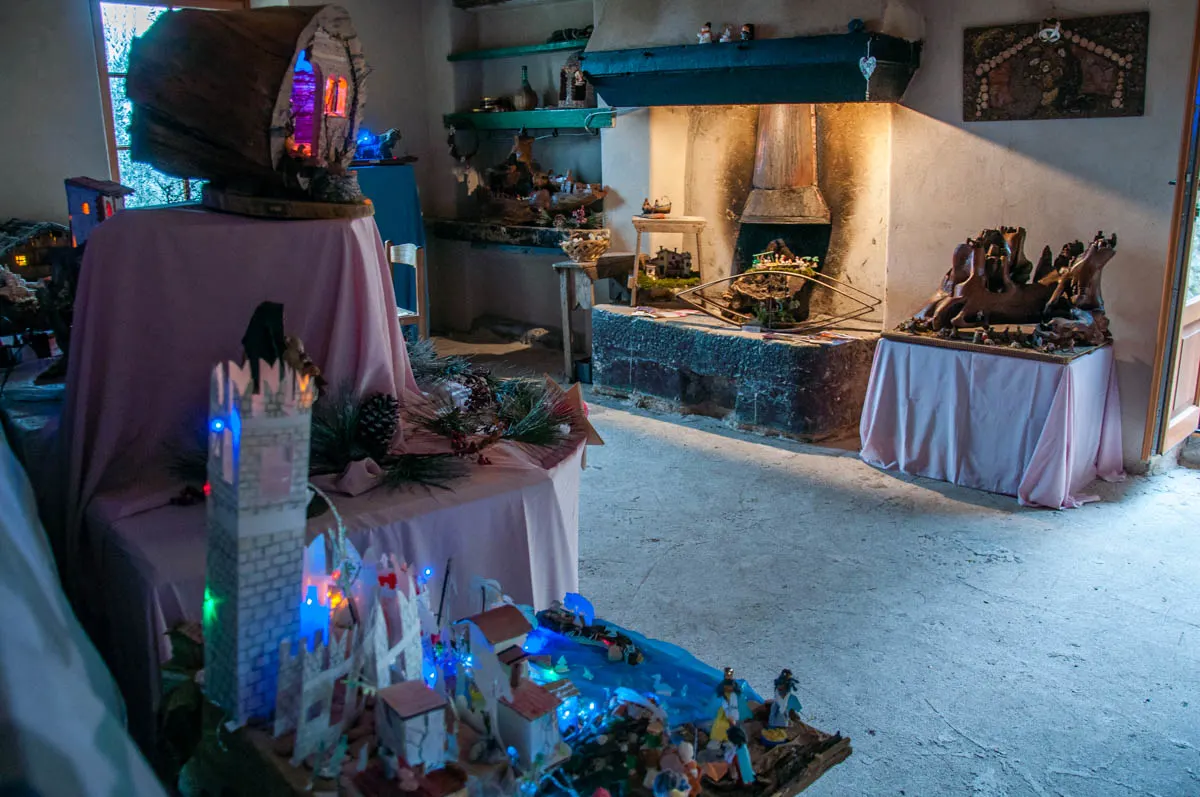
Campo di Brenzone is a small medieval village of stone houses and cobbled paths. Huddled high in the hills above Lago di Garda – Italy’s largest lake – the village can be reached only on foot. To get there, you follow stone-paved mule tracks which are hundreds of years old. It’s an energetic hike allowing you to enjoy the lovely lake views as you walk through terraced olive groves, broadleaf forests and even past centuries-old maple trees.
With a history that spans over ten centuries, nowadays, only a handful of people continue to live in Campo di Brenzone. It’s no wonder then that locally, the village is known as Il borgo fantasma – The Ghost Hamlet.
Campo di Brenzone doesn’t have running water and central heating. Yet, with its peaceful surroundings and sprawling lake views, the village is a magical place. It’s like a capsule preserving the good bygone times. Or a door that opens to a world that is no more.
Seeing the village for yourself is a great experience. Especially, if you come here between December and January. For each year, Campo di Brenzone hosts a large exhibition of Nativity Scenes.
Representing the Holy Family in the stables, Nativity Scenes are an integral part of Italy’s Christmas celebrations. Made by artists, schoolchildren, and local communities, in Campo di Brenzone you can see both traditional and modern Nativity interpretations. They show the Holy Family and the whole town of Bethelem in many different environments and are made of many different materials – from paper to wood.
Hundreds of Nativity Scenes in any possible size and style are lovingly positioned all over the village. You will find them along the cobbled streets, huddling in the roots of large trees, carefully arranged in abandoned rooms of ancient stone houses. Some Nativity Scenes are even tucked in dry-stone walls.
Visiting Campo di Brenzone is a lovely experience that helps you see Italy from a completely new point of view.
What else to see nearby:
You have the whole of Lago di Garda – Italy’s largest lake – at your disposal to explore within an easy reach from Campo di Brenzone. The nearest points of interest to the medieval village in the hills are the lakeshore towns of Malcesine and Garda. Both are a delight to see and wander around. Garda Town stands out with its lovely promenade and elegant historic villas. Malcesine has a stunning medieval castle and a state-of-art funicular taking you to the top of Monte Baldo which is the highest mountain on the shores of Lake Garda. Also within a very close reach from Campo di Brenzone, you will find Punta di San Vigilio – a superbly picturesque promontory that separates the southern part of Lake Garda from its central narrower part.
Click here for more information:
- Campo di Brenzone – A Great Day Trip to a Medieval Village in the Hills Above Lake Garda, Italy
- Best 12 Towns to Visit Around Lago di Garda – Italy’s Largest Lake
- Lake Garda with Kids or the Best 11 Things to Do at Lake Garda for Families
Cison di Valmarino, Province of Treviso
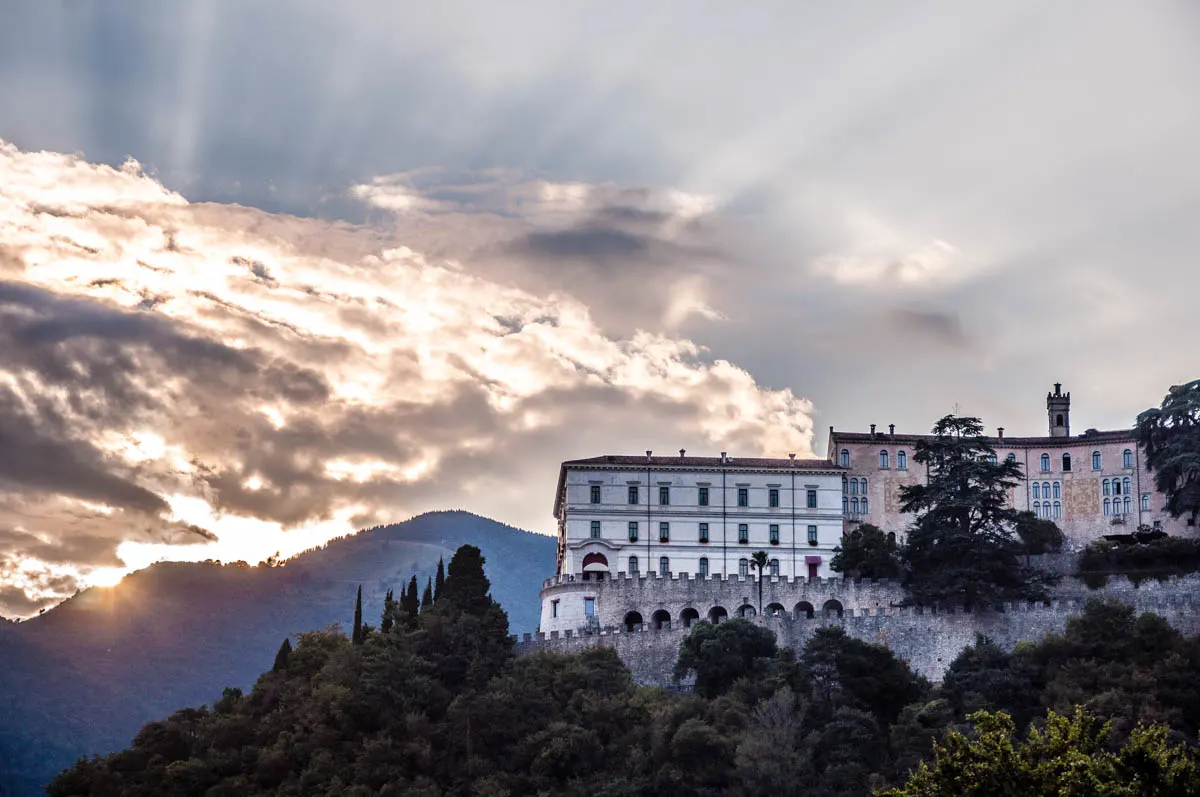
Very much off the beaten track, Cison di Valmarino is a nice and tidy village that lives under the signs of water and prosecco.
Water as the village is built on the shores of the stream Rujo which for centuries has been providing energy for the artisanal activities in this area of the Veneto’s province of Treviso.
Prosecco, as Cison di Valmarino is one of the stops on the world-renowned Prosecco Road – a circular itinerary that takes you through the best prosecco-producing spots in the Veneto’s Prosecco Hills – a UNESCO World Heritage Site.
Surrounded by terraced vineyards and lush green hills, Cison di Valmarino is overlooked by a large hilltop castle that nowadays functions as a luxury hotel. Atmospheric churches and chapels, old Venetian buildings and excellent local museums make the village a delight to explore.
Cison di Valmarino truly comes into its own during one of the many regularly held events and fairs here.
The most well-known of these are the Artigianato Vivo festivals. This is when artisans and craftsmen from all over Italy arrive in Cison di Valmarino and set-up their stalls and workshops all along the village’s streets. It’s an exciting manifestation of Italy’s centuries-old craft traditions plus visitors can come in contact with many master artisans and see them at work.
Cison di Valmarino has a long and interesting story dating back to Roman times. Nowadays the village is a magnet for nature lovers and hikers. Many hiking paths and trails start directly from the village’s historic centre. One of the best-known and picturesque ones is the so-called Via dell’Acqua. This lovely trail follows the course of the Rujo stream and allows you to discover old watermills and beautiful waterfalls.
What else to see nearby:
Cison di Valmarino is a great starting point to explore the beauty of small-town Veneto in the context of the famous Prosecco Road. Nearby you can visit another gorgeous village which is also on this list – Follina is literally 5 mins down the road from Cison di Valmarino. In addition, don’t miss the nearby stunning medieval walled towns. For example, Serravalle (Vittorio Veneto) is under 20 mins away and Conegliano is 25 mins away. There are also many unforgettable sights of natural beauty like the Revine Lakes (10 mins away), Molinetto della Croda (20 mins away), and Grotte del Caglieron (less than 30 mins away). The provincial capital Treviso is just under an hour away.
Click here for more information:
- Grotte del Caglieron – Caves, Waterfalls and Cheese – A Great Day Trip in the Veneto, Northern Italy
Follina, Province of Treviso
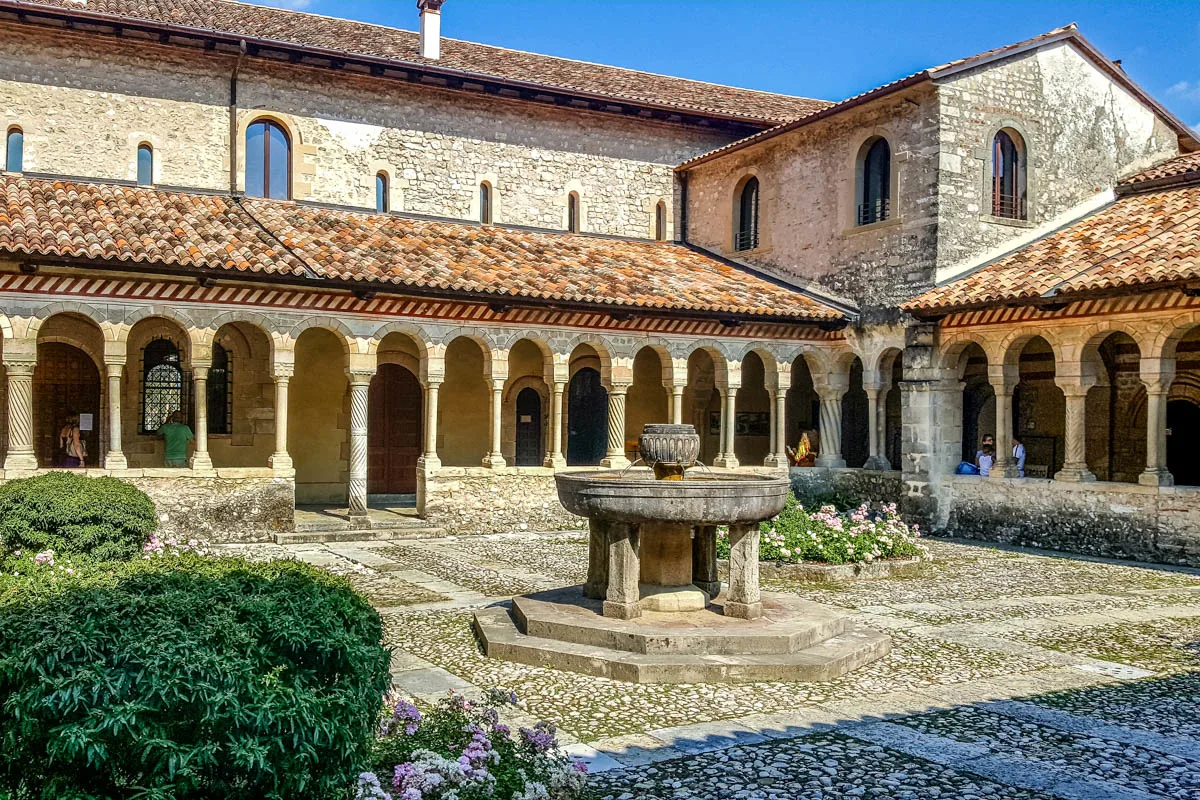
Follina is a peaceful and picturesque village in the hills of terraced vineyards along the Strada del Prosecco.
Originally, the Roman road Claudia Augusta Altinate passed across Follina’s current lands. The village then emerged in the 11th century when a group of Benedictine monks settled here. In the following century, they were replaced by Cistercian monks who founded their own abbey in Follina. The Abbey of Santa Maria di Sanavalle exists to this day and is a delight to visit. Its architecture is a lovely mixture of Romanesque and Gothic elements.
The highlight here is the spacious cloister surrounded by columns in different shapes crowned with capitals inspired by nature, symbols, and geometric figures. Next to it, don’t miss the so-called Chiostrino dell’Abate (the Abbott’s Little Cloister) where you can spend some peaceful moments admiring the goldfish swimming in two octagonal ponds.
The Abbey is an important centre of art and holds various concerts each year.
In past centuries, Follina was a famous wool- and silk-producing centre. Nowadays, a yearly event called La Via della Lana aims to revive the historical memory of the local textile production.
Set in lush nature and within close proximity to many sources of water, Follina is a hikers’ paradise.
What else to see nearby:
Follina is a great starting point to explore the beauty of small-town Veneto in the context of the famous Prosecco Road. Combine a visit to Follina with a stop at Cison di Valmarino which is just 5 mins up the road. In addition, don’t miss stunning medieval walled towns like Serravalle (Vittorio Veneto) which is 20 mins away and Conegliano which is less than 30 mins away. There are also many unforgettable sights of natural beauty like the Revine Lakes (under 15 mins away), Molinetto della Croda (15 mins away), and Grotte del Caglieron (30 mins away). The provincial capital Treviso is about an hour away.
Click here for more information:
- Grotte del Caglieron – Caves, Waterfalls and Cheese – A Great Day Trip in the Veneto, Northern Italy
Molina, Province of Verona
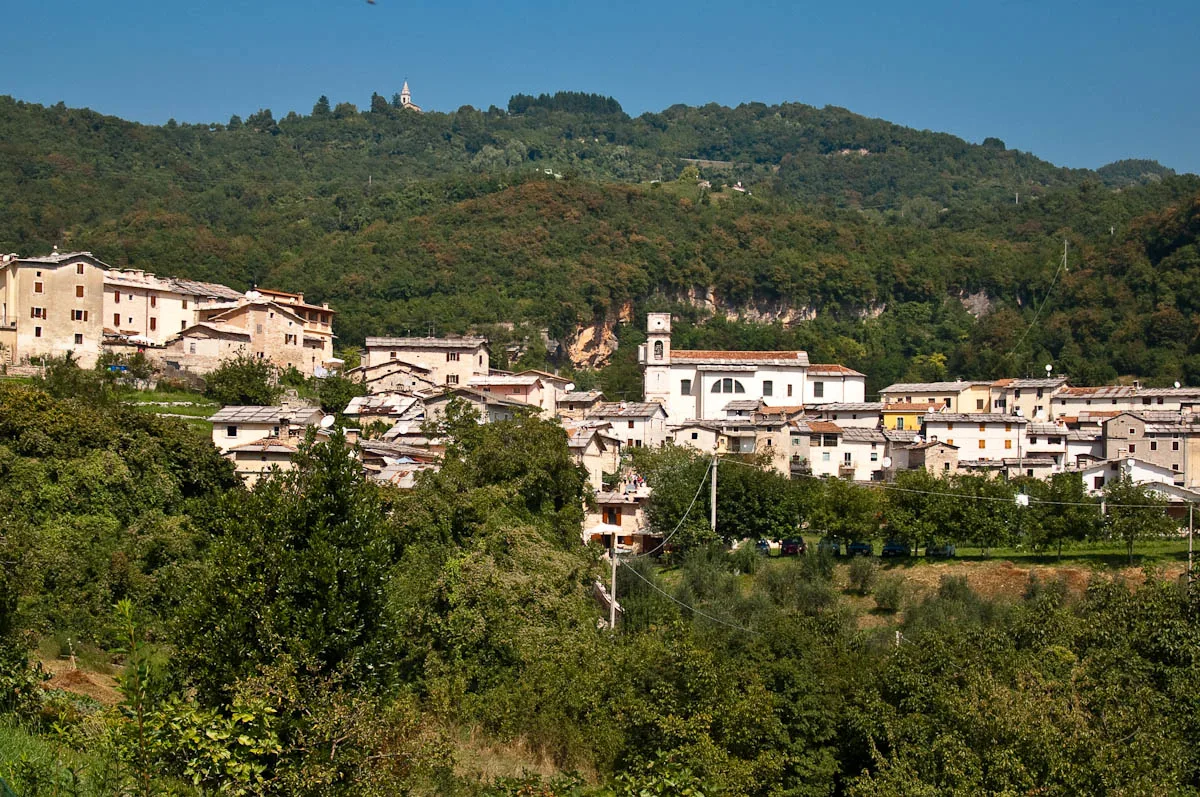
Molina is a magical medieval village lost in the green folds of the western part of the Veneto’s Lessinia Hills. With traditional stone houses covered with slate roofs and a couple of centuries-old mills nearby, Molina is a must-see if you are looking to explore this part of Italy authentically.
Plus, next door to the village, there is a large nature park – Parco delle Cascate. This is where you can see 18 waterfalls and a couple of caves where pre-historic tribes used to live.
Visiting both Molina and the Waterfall Park in one day is a great idea. Start with the park first and hike one or more of its three trails. Then spend a relaxing afternoon in Molina. If you are lucky, there may be an event going on so you will see the small village filled with the stalls of local producers selling handmade and bioproducts.
Keep an eye out for the signs in the centre of Molina which point you in the direction of the mills and the local communal dairy.
The name of Molina, in fact, comes from the Italian word mulino meaning ‘mill’. Since about the 10th century the village used to be home to many mills (17 at its heyday). They were fed by the fast streams that create the waterfalls in the park.
Nowadays there are two mills left here.
One – Lorenzo’s Mill – has recently been restored. It was originally built in 1766 and it was used for pressing wool and grinding cereals.
The Veraghi’s Mill is the other surviving mill. Surrounded by tall lush trees, the mill has been standing at that beauty spot for over 400 years. It is the only surviving mill from the original mills which gave Molina its name. It is still in operation nowadays and its big heavy stones moved by a set of wooden gears still mill polenta as in the days of yore.
The local dairy was founded in 1879. Nowadays, its building is used for cheese-making workshops. In its heyday, the dairy functioned as a Malga Turnaria. In other words, each day each member of the local collective of dairy-farmers would take to the Malga his cows’ milk and write the number of litres on a specific measuring tool.
The quantity was then added to his credit or debit. The member with the most credit could take everybody’s milk and use it to make cheese. The litres of milk used were then subtracted from his credit. He would then repay the used quantity of milk by bringing his milk to the Malga in the following days. This way, each member would have enough milk to make cheese for his family.
What else to see nearby:
There are many picturesque places you can easily reach starting from the village of Molina. If you like caves, head straight to the nearby Grotta di Fumane – one of Europe’s most highly regarded monuments of ancient prehistory. You can also stop at the very picturesque San Giorgio di Valpolicella – see entry below – which is about 30 mins away from Molina. Or you can drive straight to Verona which is only about 40 mins away. Several towns on the shores of Lake Garda – like Bardolino, Lazise, Garda Town, and Peschiera del Garda – can be reached in about 40-50 mins. The rock-hewn Sanctuary of Madonna della Corona is less than an hour away from Molina.
Click here for more information:
- Parco delle Cascate and Molina – A Great Day Out in the Province of Verona
- Best 12 Towns to Visit Around Lago di Garda – Italy’s Largest Lake
- Lake Garda with Kids or the Best 11 Things to Do at Lake Garda for Families
- 20 Best Things to Do in Verona, Italy in One Day – The Ultimate Itinerary with Photos and Tips
- Sanctuary of Madonna della Corona – Visiting Italy’s Church Suspended Between Heaven and Earth
San Giorgio di Valpolicella, Province of Verona
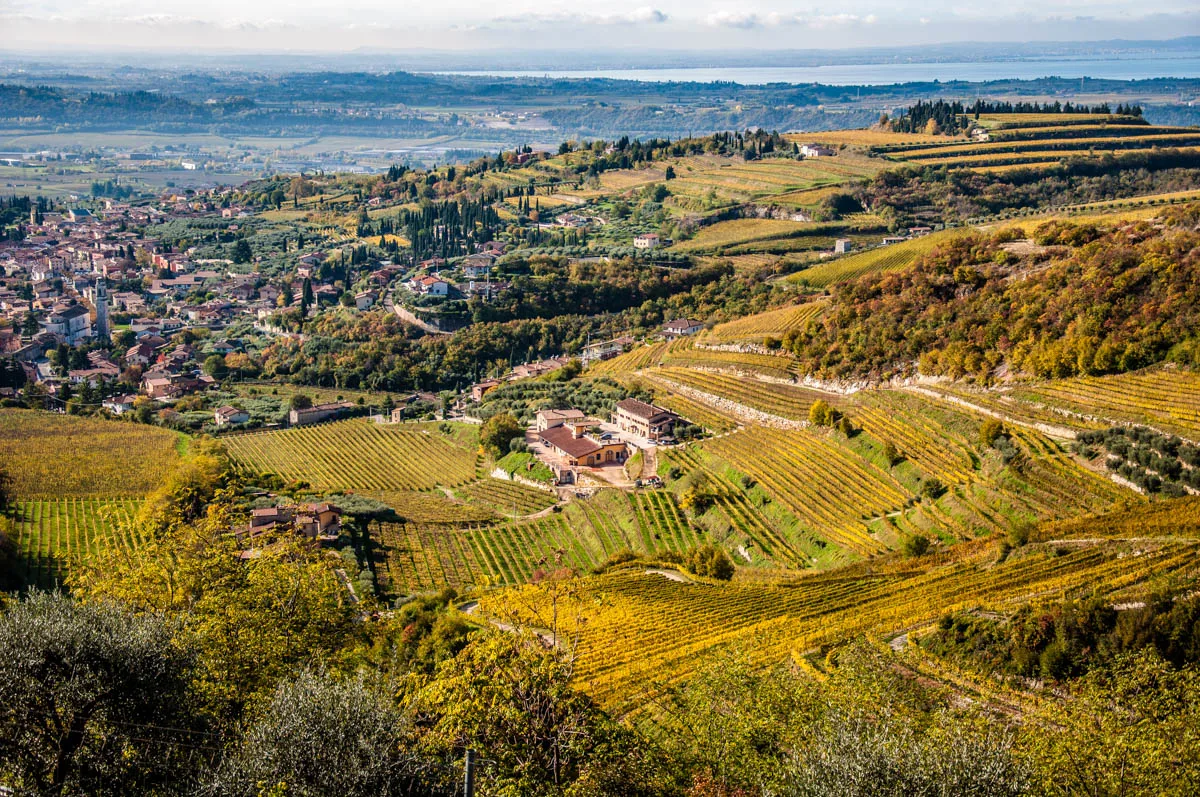
San Giorgio di Valpolicella is a tiny hilltop village with overwhelmingly beautiful views.
The village’s main square is shaped like a terrace, so you can sit on a stone bench and spend some charmed moments of your life looking as far afield as Lake Garda and the Po Valley. The Monte Solane on which the village stands is 650 m tall so you feel like a bird looking at the world beneath your wings.
The hills around you are covered with terraced vineyards and dotted with farmhouses and wineries. In the small valley below you can see the town of Sant’Ambrogio di Valpolicella. And then, further afield, the eye caresses the blue expanse of Italy’s largest lake with the narrow promontory on which the town of Sirmione is placed stretching right into it.
It’s beautiful!
San Giorgio di Valpolicella is worth it the drive from nearby Verona or Lake Garda. Since the Middle Ages the village is also known with the moniker Ingannapoltron – Deceiving the Lazy Ones – as it seems easy to reach it yet the road that leads to it is sinuous and long.
The area of the village has been populated since prehistoric times. Ancient tribes must have appreciated beautiful views just as much as we do.
Archaeological excavations have unearthed different testaments to life there dating as far back as the Bronze Age. In addition, a beautiful stone church dating back to the 11th-century stands in the centre of the village. Called Pieve di San Giorgio di Valpolicella, it’s one of the best examples of the Romanesque architectural style in the Province of Verona. Inside the church, there are some interesting frescoes. Behind the church, there is a small, atmospheric cloister.
The most famous local products are the Amarone wine and the red Verona marble which has been extracted in the area since ancient times.
What else to see nearby:
Starting from San Giorgio di Valpolicella you can easily explore many other beautiful and unique sights in its vicinity. You can spend time in the village of Molina (see entry above) and its adjacent Parco delle Cascate – a gorgeous hiking park with 18 waterfalls and also with some prehistoric caves. If you like caves, don’t miss the Grotta di Fumane – one of the most highly regarded monuments of ancient prehistory. Another option is to head straight to Fair Verona which is only about half an hour away. Several towns on the shores of Lake Garda – like Bardolino, Lazise, Garda Town, and Peschiera del Garda – can be reached in anything from 20 to 35 mins. The rock-hewn Sanctuary of Madonna della Corona is only about 40 mins away from San Giorgio di Valpolicella.
Click here for more information:
- Parco delle Cascate and Molina – A Great Day Out in the Province of Verona
- Best 12 Towns to Visit Around Lago di Garda – Italy’s Largest Lake
- Lake Garda with Kids or the Best 11 Things to Do at Lake Garda for Families
- 20 Best Things to Do in Verona, Italy in One Day – The Ultimate Itinerary with Photos and Tips
- Sanctuary of Madonna della Corona – Visiting Italy’s Church Suspended Between Heaven and Earth
In Conclusion

They say that good things come in small packages. The Northern Italian region of the Veneto certainly proves this saying true as some of the most beautiful and unforgettable places to visit here are indeed its small villages.
Perched on top of steep hills, opening splendid views in front of our charmed eyes, or huddled in the green folds of the surrounding hills, the small villages of the Veneto are a delight to get to know. They preserve many authentic local traditions, centuries-old buildings and art, and often sit at places that have been inhabited since ancient times.
If you are interested in experiencing Italy off the beaten crowded path, have a look at the eight beautiful villages in the Veneto I suggest above. Each of them will reveal a small, authentic part of Italy which you may end up carrying in your heart for a very long time.
From the stone villages of Arqua Petrarca and San Giorgio di Valpolicella to the villages on the Prosecco Road like Follina and Cison di Valmarino, there are many gorgeous corners to explore and fall in love with here in the Veneto.
Enjoy!
Which of the above eight beautiful villages in the Veneto you have been to? What did you like about it the most? Which other gorgeous villages in the Veneto you would recommend that I add to this list? Let me know in the comments below.
More Helpful Links
- Italian Villages or 6 Reasons to Visit Italy’s Picturesque and Historic Borghi
- 5 Most Beautiful Villages to Visit in Emilia-Romagna, Italy
- 5 Most Beautiful Villages to Visit in Friuli Venezia Giulia – The Northeasternmost Corner of Italy
- The Shortest River in Italy – Visiting the River Aril in the Village of Cassone at Lake Garda
- Top 15 Places to Visit in the Veneto, Italy – The Ultimate Guide
- 30 Days of Adventures in the Veneto, Italy – #30daysofadventures
- Italian Piazzas – 20 Most Beautiful Squares in the Veneto, Northern Italy
- Asolo – The Soul Asylum of Artists and Royals
- Campo di Brenzone – A Great Day Trip to a Medieval Village in the Hills Above Lake Garda
- Parco delle Cascate and Molina – A Great Day Out in the Province of Verona
- The Sunset that Petrarch Enjoyed
- Best 12 Towns to Visit Around Lago di Garda – Italy’s Largest Lake
- Day Trips from Verona – 16 Destinations to Fall in Love With (With Travel Times and Train Tips)
- Day Trips from Padua, Italy – Over 35 Unmissable Destinations in the Veneto, Lombardy, and Emilia-Romagna
- Day Trips from Vicenza, Italy – Over 90 of the Best Destinations
- 11 of the Best Day Trips from Venice (With Lots of Photos, Travel Times and Italy Train Tips)
- 20 Family-Friendly Walks and Hikes Up to an Hour and a Half from Vicenza, Italy – First Part
- 20 Family-Friendly Walks and Hikes Up to an Hour and a Half from Vicenza – Second Part
Thank you for reading! Please, leave me a comment, pin the image below or use the buttons right at the top and at the end of this blog post to share it on social media.
For more useful information like this, please, like my blog’s page on Facebook and subscribe to my weekly strictly no-spam newsletter.
